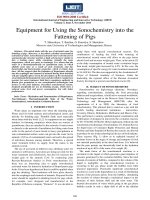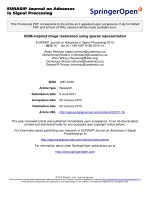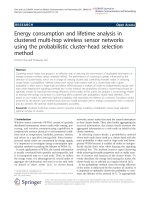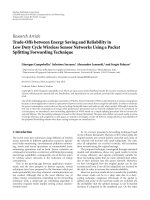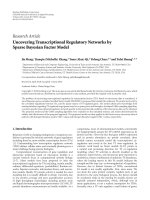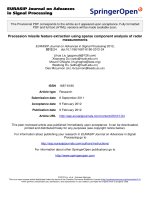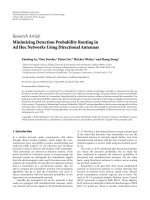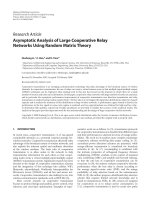WDM Optical Switching Networks Using Sparse Crossbars Yuanyuan Yang Department of Electrical &
Bạn đang xem bản rút gọn của tài liệu. Xem và tải ngay bản đầy đủ của tài liệu tại đây (404.34 KB, 12 trang )
WDM Optical Switching Networks Using Sparse Crossbars
Yuanyuan Yang
Department of Electrical & Computer Engineering
State University of New York at Stony Brook, Stony Brook, NY 11794, USA
Jianchao Wang
East Isle Technologies Inc., Setauket, NY 11733, USA
Abstract—In this paper, we consider cost-effective designs of wave-
length division multiplexing (WDM) optical switching networks for cur-
rent and future generation communication systems. Based on differen-
t target applications: we categorize WDM optical switching networks
into two connection models: the wavelength-based model and the fiber-
link-based model. Most of existing WDM optical switching network-
sbelongtothefirst category. In this paper we present new designs
for WDM optical switching networks under both models by using s-
parse crossbar switches instead of full crossbar switches in combination
with wavelength converters. The newly designed sparse WDM optical
switching networks have minimum hardware cost in terms of both the
number of crosspoints and the number of wavelength converters. The
single stage and multistage implementations of the sparse WDM optical
switching networks are considered. An optimal routing algorithm for
the proposed sparse WDM optical switching networks is also presented.
Index Terms—Wavelength division multiplexing (WDM), optical
switching networks, optical switches, network architectures, sparse
crossbars, concentrators, wavelength conversion, permutation, multi-
cast, multistage networks.
I. I
NTRODUCTION
Currently, there exists an enormous demand for bandwidth
from many emerging networking and computing application-
s, such as data-browsing in the world wide web, video confer-
encing, video on demand, E-commerce and image distribut-
ing. Optical networking is a promising solution to this prob-
lem because of the huge bandwidth of optics. As we know,
a single optical fiber can potentially provide a bandwidth of
nearly 50 terabits per second, which is about four orders of
magnitude higher than electronic data rates of a few giga-
bits per second accessed by the attached electronic devices
such as network processors or gateways. Wavelength division
multiplexing (WDM) is a promising technique to exploit such
a huge opto-electronic bandwidth mismatch. It divides the
bandwidth of an optical fiber into multiple wavelength chan-
nels so that multiple devices can transmit on distinct wave-
lengths through the same fiber concurrently. There has been
a lot of research work on WDM optical networks in the liter-
ature over the past few years, see, for example, [1]-[12].
A WDM optical switching network provides interconnec-
tions between a group of input fiber links and a group of out-
put fiber links with each fiber link carrying multiple wave-
length channels. It not only can provide much more connec-
tions than a traditional electronic switching network, but al-
so can offer much richer communication patterns for various
networking applications. Such an optical switching network
Research supported in part by the U.S. National Science Foundation under
grant numbers CCR-0073085 and CCR-0207999.
can be used to serve as an optical crossconnect (OXC) in a
wide-area communication network or to provide high-speed
interconnections among a group of processors in a parallel
and distributed computing system. A challenge is how to
design a high performance WDM optical switching network
with low hardware cost. As will be seen later, a cost-effective
design of WDM optical switching networks requires non-
trivial extensions from their electronic counterpart.
Another challenge in designing WDM optical switching
networks is how to keep data in optical domain so as to e-
liminate the need for costly conversions between optical and
electronic signals (so-called O/E/O conversions). To meet
the challenge, it is required that either the wavelength on
which the data is sent and received has to be the same, or an
all-optical wavelength converter needs to be used to convert
the signals on an input wavelength to an output wavelength.
Thus, in designing a cost-effective WDM optical switching
network, we need to reduce not only the number of cross-
points of the switching network but also the cost of wave-
length converters. We often have to make trade-offs between
the connecting capability of a WDM optical switching net-
work and the number of wavelength converters required a-
long with other design factors.
In this paper, we propose several efficient designs for
WDM optical switching networks. In Section II, we first
consider two different connection models for WDM opti-
cal switching networks: the wavelength-based model and
the fiber-link-based model, and then discuss existing design
schemes, which are generally under the wavelength-based
model. In Sections III, we present new designs for WD-
M optical switching networks with minimum cost under the
wavelength-based model and the fiber-link-based model by
using sparse crossbars. In Section IV, we consider the multi-
stage implementation of the proposed optical switching net-
works. Section V gives a comparison in hardware cost be-
tween the new designs and previous ones. Finally, Section VI
concludes the paper, and the Appendix contains some math-
ematical proofs.
II. B
ACKGROUND AND
P
REVIOUS
W
ORK
Based on different applications, WDM optical switching
networks can be categorized into two connection models: the
wavelength-based model and the fiber-link-based model, de-
pending on whether a single device attached to the switching
network occupies a single input/output wavelength or a sin-
gle input/output fiber link. Under the wavelength-based mod-
0-7803-8356-7/04/$20.00 (C) 2004 IEEE IEEE INFOCOM 2004
el, each device occupies one wavelength on an input/output
fiber link of a WDM optical switching network. Under the
fiber-link-based model, each device occupies an entire in-
put/output fiber link (with multiple wavelength channels) of
a WDM optical switching network. These two models are
used in different types of applications. In the former each
device could be an independent, simple device that need-
s only one communication channel, and in the latter each
device could be a more sophisticated one with multiple in-
put/output channels, such as a network processor capable of
handling concurrent, independent packet flows, for example,
MMC Networks’ NP3400 processor [13] and Motorola’s C-
port network processor [14]. Also, some “hybrid” models
are possible, e.g. adopting the wavelength-based model on
the network input side and the fiber-link-based model on the
network output side. As can be expected, a switching net-
work with wavelength-based model has stronger connection
capabilities than that with fiber-link-based model, but it has
higher hardware cost.
In addition, the communication patterns realizable by an
optical switching network can be categorized into permuta-
tion (one-to-one), multicast (one-to-many) andsoon.Appar-
ently, the exact definitions of these terms under different con-
nection models could be somewhat different. In permutation
communication under the wavelength-based model, each idle
input wavelength can be connected to any idle output wave-
length with the restriction that an input wavelength cannot be
connected to more than one output wavelengths and no two
input wavelengths can be connected to the same output wave-
length. In multicast communication under the wavelength-
based model, each idle input wavelength can be connected
to a set of idle output wavelengths, but no two input wave-
lengths can be connected to the same output wavelength. For
presentational convenience, in the rest of the paper we refer
to multiple such multicast connection requests as a multicast
assignment, and if every output wavelength is involved in a
multicast connection in the assignment, the multicast assign-
ment is called a full multicast assignment.
For communication patterns under the fiber-link-based
model, since they were not fully discussed in the literature,
we elaborate them more here. The possible connections be-
tween a number of input fiber links and a number of output
fiber links (with each fiber link carrying k wavelengths) can
be illustrated as a bipartite graph as shown in Fig. 1, where
each link between two nodes in the bipartite graph is actually
a k-fold link. The major difference is that the wavelengths on
a fiber link are treated as indistinguishable ones in the fiber-
link-based model. That is, the connections are between the
input and output fiber links, not between the input and output
wavelengths as in the wavelength-based model.
In permutation communication under the fiber-link-based
model, each input (output) fiber link can be involved in up
to k independent one-to-one connections to k
0
(1 ≤ k
0
≤ k)
output (input) fiber links. Notice that any pair of idle wave-
lengths on an input fiber link and an output fiber link can
k
k
k
k
k
k
k
k
k
Fig. 1. Possible connections between input and output fiber links (each
carrying k wavelengths) as a bipartite graph.
be used to realize a one-to-one connection between the input
and the output fiber links; and there may be more than one
distinct one-to-one connections between an input fiber link
andanoutputfiber link. Similarly, in multicast communi-
cation under the fiber-link-based model, each input (output)
fiber link can be involved in up to k independent one-to-many
connections. To realize a multicast connection between an
input fiber link and a subset of output fiber links, we can pick
any idle wavelength on each fiber link involved.
For multicast communication patterns applied to a WDM
switching network under either the wavelength-based model
or the fiber-link-based model, we have the restriction that a
multicast connection cannot have more than one destination
wavelengths on the same output fiber link. To see the reason
why this restriction is necessary, let’s look at the situation
shown in Fig. 2, where WDM switching networks are used
as crossconnects (nodes) in a wide area network (WAN), and
the input (output) fiber links of WDM switching networks
are links in the WAN. Thus, two destination wavelengths of a
multicast connection being on one fiber link implies that two
independent channels on some fiber link in the WAN carry
the same message. Clearly, it wastes network bandwidth and
violates the principle of multicast communication. In either
the wavelength-based model or the fiber-link-based model,
when a multicast connection involves more than one desti-
nation wavelengths on the same fiber link at some node, the
multicast route in any intermediate WDM switching network
is still connected to only one of the destination wavelengths,
and it is the final destination node’s responsibility to relay the
multicast message to the rest of destination wavelengths.
For a k-wavelength WDM switching network with N in-
put fiber links and N output fiber links, it is interesting to
know how many different permutation and multicast connec-
tion patterns the WDM switching network can realize. For
such a WDM switching network under the wavelength-based
model, the number of permutation assignments realizable can
be easily calculated as
N
W,perm
=(Nk)! (1)
and the number of multicast assignments realizable is
N
W,mcast
=
·µ
Nk
k
¶
k!
¸
N
(2)
according to [12]. However, it is much more difficult to
calculate the numbers of permutation and multicast assign-
0-7803-8356-7/04/$20.00 (C) 2004 IEEE IEEE INFOCOM 2004
WDM
Crossconnect
WDM
Crossconnect
WDM
k wavelengths
WDM
Crossconnect
Crossconnect
k wavelengths
k wavelengths
Fig. 2. WDM switching networks used as crossconnects in a WAN.
ments for a WDM switching network under the fiber-link-
based model. Here we give some bounds on such numbers.
Lemma 1: For a k-wavelength WDM switching network
with N input fiber links and N output fiber links under the
fiber-link-based model, let the numbers of different full per-
mutation and multicast assignments that can be realized in
the network be N
F,perm
and N
F,mcast
, respectively. We have
that
s(k,N)
Y
t=1
(N − t +1)!≤ N
F,perm
≤
(Nk)!
(k!)
N
, (3)
where s(k,N)=min{b
√
8k+1−1
2
c,N},and
µ
N
k
¶
N
≤ N
F,mcast
≤
µ
Nk
k
¶
N
(4)
Proof. See Appendix.
Finally, with respect to nonblocking capability, WDM
switching networks can be categorized into strictly nonblock-
ing, wide-sense nonblocking,andrearrangeably nonblocking
(or simply rearrangeable). In a strictly nonblocking switch-
ing network, any legal connection request can be arbitrari-
ly realized without any disturbance to the existing connec-
tions. Different from a strictly nonblocking network, in a
wide-sense nonblocking switching network, a proper routing
strategy must be adopted in realizing any connection requests
to guarantee the nonblocking capability. In a rearrangeably
nonblocking switching network, any legal connection request
can be realized by permitting the rearrangement to on-going
connections in the network. Rearrangeable switching net-
works are usually adopted in applications with scheduled,
synchronized network connections, in which case, rearrange-
ment to on-going connections could be avoided.
From the above discussions, we can see that a WDM opti-
cal switching network does offer much richer communication
patterns than a traditional electronic switching network. For
example, in a permutation under the wavelength-based mod-
el, a specific wavelength on the input side can be connected
only to a specific wavelength on the output side, while in a
permutation under the fiber-link-based model, a wavelength
on a specific input fiber link can be connected to any one of
the wavelengths on a specific output fiber link. As will be
seen later, this difference in connection models will lead to
switching network designs with different costs.
There has been a considerable amount of work in the liter-
ature, e.g. [3], [9], [10], [11], on the wavelength requirement
in a WDM network to support permutation and/or multicas-
t communication patterns among the nodes of the network.
We view this type of work is in the category of the fiber-link-
based model, because they actually pursue that for a given
network topology (with fixed parameters), how many wave-
lengths are required in the network so that the network can
realize all permutation (or multicast) connections among the
network nodes. On the other hand, under the wavelength-
based model, it pursues that for a given network topology
and the number of wavelengths per fiber link, under what net-
work parameters we can achieve permutation (or multicast)
between input wavelengths and output wavelengths with a
certain type of nonblocking capability.
In this paper, we propose optimal designs of WDM opti-
cal switching networks under both the wavelength-based and
fiber-link-based models for various communication patterns.
In the following, if not specifically mentioned, the WDM op-
tical switching network we consider is under the wavelength-
based model.
In general, the switching network considered in this paper
has N input fiber links and N output fiber links, with each
single fiber link carrying k wavelengths λ
1
,λ
2
,...,λ
k
.The
set of input links is denoted as I = {i
1
,i
2
,... ,i
N
} and the
set of output links is denoted as O = {o
1
,o
2
,...,o
N
}.Anin-
put wavelength λ
k
1
on link i
j
is denoted as (i
j
,λ
k
1
) and an
output wavelength λ
k
2
on link o
p
is denoted as (o
p
,λ
k
2
).An
input wavelength can be connected to an output wavelength
through the switching network according to certain commu-
nication patterns.
A typical WDM optical switching network consists of de-
multiplexers, multiplexers, splitters, combiners, and wave-
length converters. The demultiplexers are used to decompose
input fiber links to individual wavelength signals, the multi-
plexers are used to combine individual wavelength signals
to output fiber links, splitters and combiners perform cross-
connecting functions among wavelength signals, and wave-
length converters are used to change the wavelengths of sig-
nals. Semiconductor optical amplifiers (SOAs) are also used
to pass or block selected signals. Fig. 3 gives an example of
such a switching fabric. An output of a splitter and an input of
a combiner contribute one crosspoint of the optical switching
network. A major design issue is to find the minimal possible
number of crosspoints for such a switching network .
For an N × N WDM optical switching network with k
0-7803-8356-7/04/$20.00 (C) 2004 IEEE IEEE INFOCOM 2004
DMUX
λ
1
λ
1
λ
1
λ
1
λ
2
λ
2
λ
2
λ
2
DMUX
WC
WC
MUX
WC
WC
MUX
λ
2
λ
1
λ
2
λ
1
λ
2
λ
1
λ
2
λ
1
1
o
2
o
i
2
i
1
S
S
Splitter Combiner
SOA
Wavelength Converter
S
S
C
C
C
C
INPUTS
OUTPUTS
Fig. 3. A 2 × 2 switchingfabricwith2wavelengths.
wavelengths, we can adopt different design schemes. In
some existing designs, e.g. [1], [7], [12], the network can
be decomposed into kN×N crossconnects as shown in Fig.
4(a), where connections in the i
th
N × N crossconnect are
all on wavelength λ
i
. This design scheme has the lowest
number of crosspoints compared to other schemes. Howev-
er, it is only suitable for communication patterns in which
the same wavelength is assigned to the source and destina-
tion of a connection. For example, it cannot realize one-to-
one connections (i
1
,λ
1
) → (o
1
,λ
2
), (i
2
,λ
2
) → (o
1
,λ
1
) and
(i
2
,λ
1
) → (o
1
,λ
3
).
One may argue that the design can be improved by adding
a set of wavelength converters between the outputs of al-
l N × N 1-wavelength crossconnects and the output fiber
links as shown in Fig. 4(b). Certainly, it can realize more
communication patterns, for example, one-to-one connec-
tions (i
1
,λ
1
) → (o
1
,λ
2
) and (i
2
,λ
2
) → (o
1
,λ
1
) now are re-
alizable. However, this is not sufficient for realizing all such
communication patterns. For example, it cannot realize an
additional legal connection (i
2
,λ
1
) → (o
1
,λ
3
) because the
N ×N crossconnect with wavelength λ
1
has only one output
to the first output fiber link.
On the other hand, one could consider the scheme that an
N ×N WDM optical switching network with k-wavelengths
is equivalent to an Nk× Nk crossconnect followed by Nk
wavelength converters as shown in Fig. 5. Clearly, an ar-
bitrary permutation can be realized in a permutation WDM
optical switching network adopting this design scheme. In
the existing designs, an Nk × Nk crossconnect consists of
one stage or multistage full crossbar(s). However, as will be
seen in the next section, these designs do not always yield
the minimum number of crosspoints for switching networks
under different connection models.
III. N
EW
D
ESIGNS OF
WDM S
WITCHING
N
ETWORKS
U
SING
S
PARSE
C
ROSSBARS
In our new designs, we still consider the scheme that al-
ways places one wavelength converter immediately before
each output wavelength shown in Fig. 5. Different from the
existing designs, sparse crossbars instead of full crossbars are
λ
1
λ
1
λ
1
λ
2
λ
2
λ
k
λ
k
λ
k
λ
2
DMUX
DMUX
DMUX
λ
1
λ
1
λ
1
λ
2
λ
2
λ
2
λ
k
λ
k
λ
k
i
1
i
2
i
N
2
o
N
o
λ
1
λ
1
λ
1
λ
2
λ
2
λ
2
DMUX
DMUX
λ
1
λ
1
λ
1
λ
2
λ
2
λ
2
i
1
i
2
2
o
λ
k
λ
k
λ
k
DMUX
λ
k
λ
k
λ
k
i
N
N
o
MUX
(b)
N X N
Crossconnect
MUX
1
o
MUX
Wavelength converter
N X N
Crossconnect
N X N
Crossconnect
(a)
MUX
MUX
MUX
1
o
N X N
Crossconnect
N X N
Crossconnect
N X N
Crossconnect
Fig. 4. Different design schemes for WDM optical switching networks. (a)
Consisting of k parallel N × N 1-wavelength crossconnects. (b) Adding
wavelength converters between the outputs of all N × N 1-wavelength
crossconnects and the output fiber links.
used to build an Nk × Nk crossconnect, so that the number
of crosspoints of a WDM optical switching network can be
reduced.
The question is whether we can use a sparsely connected
Nk× Nk crossconnect and still guarantee that a WDM op-
tical switching network possesses full connecting capability
(e.g. realizing an arbitrary permutation or a multicast assign-
ment). An important fact we may make use of in our design
is that the placement of wavelength converters can eliminate
the need to distinguish the k outputs on a single output fiber
link of a switching network. In other words, we can consider
the k wavelengths on an output fiber link as a group and do
not distinguish their order within the group. We will for-
mally prove the correctness of the WDM switching network
designs based this concept later in this section.
In this paper, we consider using a type of sparse cross-
0-7803-8356-7/04/$20.00 (C) 2004 IEEE IEEE INFOCOM 2004
i
1
i
2
i
N
2
o
λ
1
λ
2
λ
k
DMUX
DMUX
λ
1
λ
2
λ
k
DMUX
λ
1
λ
2
λ
k
MUX
1
o
MUX
λ
2
λ
k
λ
1
λ
k
λ
1
λ
1
λ
k
N
o
Nk X Nk
Crossconnect
WC
MUX
λ
2
λ
2
Fig. 5. An N × Nk-wavelength WDM optical switching network architec-
ture consisting of an Nk × Nk crossconnect followed by Nk wavelength
converters.
bars, concentrators (as defined below), to design WDM opti-
cal switching networks with optimal hardware cost.
A. Concentrators and Reverse Concentrators
In general, a p × q (p ≥ q) concentrator isasparsecross-
bar with p inputs and q outputs, in which any q of p inputs
can be connected to the q outputs without distinguishing their
order. There has been a lot of work on concentrators, see,
for example, [18]-[22]. In [20], a lower bound on the num-
berofcrosspointsforap × q concentrator was given to be
(p − q +1)q. In the literature, some p ×q concentrators with
the minimum (p − q +1)q crosspoints were designed, such
as the so-called fat-and-slim concentrator in [21] and banded
concentrator in [22]. In these designs, each output link of the
concentrator has a degree of (p − q +1). Clearly, the number
of crosspoints in designs [21], [22] matches the lower bound
and thus the designs are optimal. Also, notice that the num-
ber of crosspoints is much less than the p · q crosspoints of a
p × q full crossbar. In this paper, we will adopt the banded
concentrator which has a more regular crosspoint layout.
The p × q (banded) concentrator in [22] can be described
as a banded sparse crossbar. That is, each of the consecutive
p − q +1 inputs i, i +1,... ,p− q + i has a crosspoint to
output i,for1 ≤ i ≤ q. It was indirectly proved in [22] that
a p × q sparse crossbar described above is a concentrator by
showing its equivalence to a fat-and-slim concentrator. In
this paper, we give a direct proof for the following theorem
to further demonstrate its concentration capability. Our direct
proof also implicitly provides a routing algorithm for banded
concentrators.
Theorem 1: A p × q (p ≥ q) banded sparse crossbar de-
scribed above is a concentrator (and thus called a banded
concentrator).
q = 3
p = 6
(c)
p = 6
q = 3
(a)
1
2
3
1
23
45 6
1
231
2
3
4
5
6
(b)
Outputs
Inputs
Inputs
Outputs
(d)
Fig. 6. A 6 × 3 concentrator and a 3 × 6 reverse concentrator with the
minimum number of crosspoints. (a) The diagram of the concentrator. (b)
The crosspoint layout of the concentrator. (c) The diagram of the reverse
concentrator. (d) The crosspoint layout of the reverse concentrator.
Proof. See Appendix.
Fig. 6(a) and (b) show a 6 × 3 concentrator and its cross-
point layout. As can be seen, the number of crosspoints in
6 × 3 concentrator is 12, which is less than 18, the number
of crosspoints in a 6 × 3 full crossbar. Also, from the cross-
point layout, it can be verified that any three inputs can be
connected to the three outputs.
In this paper, we introduce reverse concentrators which
will also be used in the designs of WDM optical switching
networks. A q × p (p ≥ q) reverse concentrator is a sparse
crossbar with q inputs and p outputs, in which any q of p
outputs can be connected to the p inputs without distinguish-
ing their order. We still consider the banded reverse concen-
trator. Its definition is symmetric to that of a banded con-
centrator. That is, each of the consecutive p − q +1outputs
i,i+1,... ,p−q +i has a crosspoint to input i,for1 ≤ i ≤ q.
Fig. 6(c) and (d) show a 3 × 6 reverse concentrator and its
crosspoint layout. It can be verified that any three outputs
can be connected to the three inputs.
B. Sparse WDM Switching Networks Using Concentrators
B.1 Construction of Sparse WDM Switching Networks
We now consider using concentrators in a single stage
WDM optical switching network to reduce the network cost.
Since in an Nk × Nk crossconnect, every k outputs corre-
sponding to k wavelengths of an output fiber link may be
indistinguishable in routing, we can use an Nk× k (banded)
concentrator to connect all Nk inputs and the k outputs as
showninFig.7(a).Thus,forN output fiber links, we use N
such concentrators to connect all the Nk inputs and all the
Nk outputs as shown in Fig. 7(b) so that every k outputs are
indistinguishable. Such an Nk× Nk crossconnect is simply
called output-indistinguishable sparse crossbar.
Similarly, we can use reverse concentrators to construct an
Nk× Nk
crossconnect to connect all Nk inputs and Nk out-
puts so that every k inputs are indistinguishable. This type of
crossconnect is called input-indistinguishable sparse cross-
bar. The construction is to put
Nk× Nk
reverse concentra-
tors together by sharing the Nk outputs and can be viewed as
flipping the crossconnect in Fig.7(b) between its inputs and
outputs.
We are interested in whether there exists a crossconnect
that can function as both an output-indistinguishable sparse
crossbar and an input-indistinguishable sparse crossbar, and
if it exists, what its cost would be. Such a crossconnec-
t is called bi-directional-indistinguishable sparse crossbar
0-7803-8356-7/04/$20.00 (C) 2004 IEEE IEEE INFOCOM 2004


